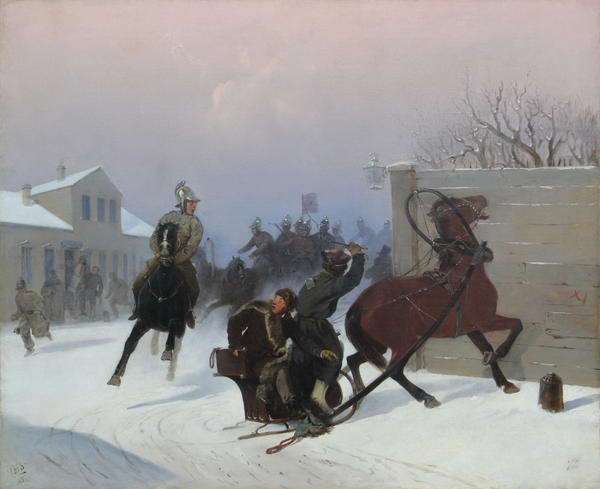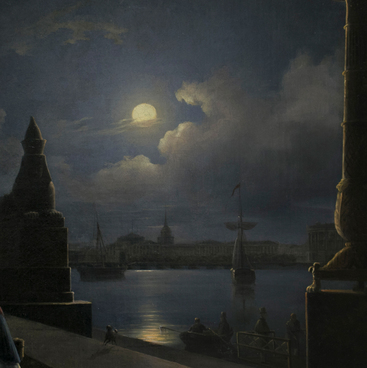The genre painting The Turn-Out of a Fire Brigade was produced by painter and graphic artist Georgi Destunis in 1858. Its action is unfolding amidst a winter scenery. It is one of rare depictions of winter in the Russian art of the mid-19th century. When the Itinerants emerged as trendsetters in art, winter landscapes became a more widespread occurrence, but before them, Russian artists had painted winter but very seldom.
In his painting, Destunis captured a dynamic scene when a fire brigade suddenly comes across a private sledge in a street. The man in the sledge looks back in fear and tries to keep his balance, and the coachman is raising a whip at his horse. He is trying to free the passage, but the frightened horse comes against a fence, neighing loudly. A horseman in a fireman’s uniform, with a shining helmet on his head, dashes at them, closely followed by a horse team carrying the other members of the fire brigade.
In Destunis’ times, a turn-out of a fire brigade was an unusual phenomenon, because first professional fire units started to emerge in cities only in the early 19th century. Before that, fires had been put out by the police and the military. When firefighters responded to a call, a uniformed horseman usually preceded them, trying to free passage for the brigade. This is exactly the scene in the picture.
Destunis’ The Turn-Out of a Fire Brigade belongs to the early stage of Russian genre painting. The painter liked winter scenery, and the action in all of his extant paintings takes place in winter. He was very observant and often used in his pictures some expressive details that enlivened the subject matter, sometimes resorted to grotesque and satirical techniques used by cartoonists. However, Destunis’ paintings lack social poignancy and a critical slant that distinguished the art of the ‘Men of the Sixties.’
There is only scanty information about the artist’s life and creative career. He was the son of a consul general in Smyrna; painter Maxim Vorobyov turned to the latter for advice when he was traveling in the Orient. Destunis attended his first drawing and painting classes in Venice, and later he enrolled at St. Petersburg University. The career of a public official did not appeal to Destunis, so he retired pretty soon and embraced painting. Five of his works were exhibited at an art show in the Imperial Academy of Arts in 1875.
Destunis preferred to use a monogram to sign his pictures, instead of a full name. He rarely signed his graphic works, so it is not easy to identify and correctly attribute his drawings and lithographs.
In his painting, Destunis captured a dynamic scene when a fire brigade suddenly comes across a private sledge in a street. The man in the sledge looks back in fear and tries to keep his balance, and the coachman is raising a whip at his horse. He is trying to free the passage, but the frightened horse comes against a fence, neighing loudly. A horseman in a fireman’s uniform, with a shining helmet on his head, dashes at them, closely followed by a horse team carrying the other members of the fire brigade.
In Destunis’ times, a turn-out of a fire brigade was an unusual phenomenon, because first professional fire units started to emerge in cities only in the early 19th century. Before that, fires had been put out by the police and the military. When firefighters responded to a call, a uniformed horseman usually preceded them, trying to free passage for the brigade. This is exactly the scene in the picture.
Destunis’ The Turn-Out of a Fire Brigade belongs to the early stage of Russian genre painting. The painter liked winter scenery, and the action in all of his extant paintings takes place in winter. He was very observant and often used in his pictures some expressive details that enlivened the subject matter, sometimes resorted to grotesque and satirical techniques used by cartoonists. However, Destunis’ paintings lack social poignancy and a critical slant that distinguished the art of the ‘Men of the Sixties.’
There is only scanty information about the artist’s life and creative career. He was the son of a consul general in Smyrna; painter Maxim Vorobyov turned to the latter for advice when he was traveling in the Orient. Destunis attended his first drawing and painting classes in Venice, and later he enrolled at St. Petersburg University. The career of a public official did not appeal to Destunis, so he retired pretty soon and embraced painting. Five of his works were exhibited at an art show in the Imperial Academy of Arts in 1875.
Destunis preferred to use a monogram to sign his pictures, instead of a full name. He rarely signed his graphic works, so it is not easy to identify and correctly attribute his drawings and lithographs.


